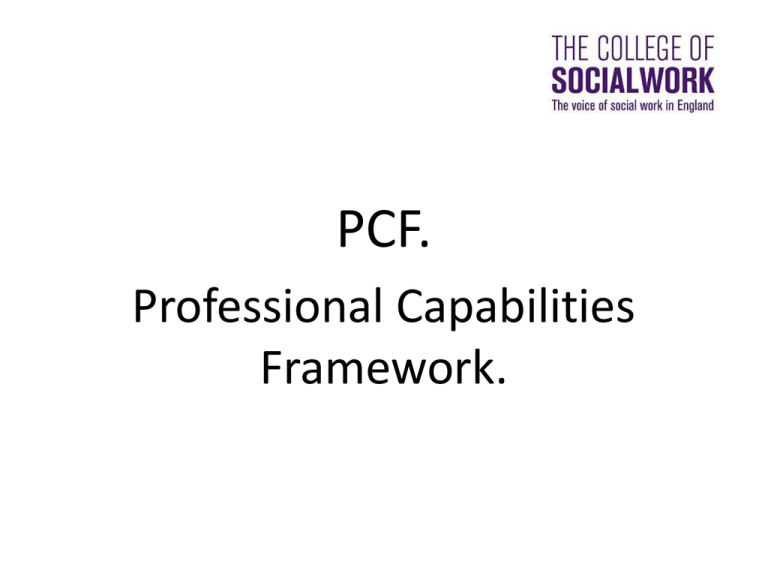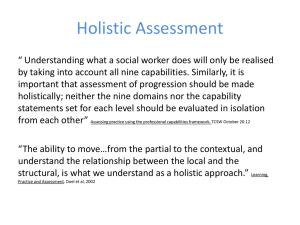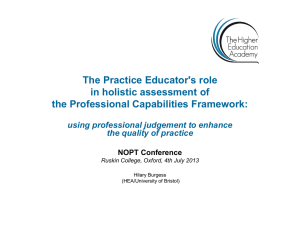Introduction to the purpose and nature of the PCF for qualifying
advertisement

PCF. Professional Capabilities Framework. Professional Capabilities Framework • These are the areas we will be covering: • What is the PCF and what is its purpose? • The role of the PCF in qualifying education: the 4 levels. • Holistic assessment: what is it and why is it needed? • Guidance from the TCSW and the HEA. • Links to the ASYE. • Some challenges. What is the PCF and what is its purpose? The PCF ‘sets out the profession’s expectations of what a social worker should be able to do at each stage of their career and professional development’. Taken from: Purpose, development and use of the PCF for Social Workers’. http://www.basw.co.uk/resource/?id=1156 What is the PCF and what is its purpose? (cont) • 9 domains and 9 levels. • Domains are interdependent. • Relevant to social workers in all settings and with all user groups. • First attempt to provide a professional framework linked to career progression. • Developed by social workers for social workers, held by TCSW on behalf of profession. • Will change and develop to reflect changes/developments to the profession. The 9 domains. 1. 2. 3. 4. 5. 6. 7. 8. 9. Professionalism. Values and Ethics. Diversity. Rights, Justice and Economic Well-being. Knowledge. Critical Reflection and Analysis. Intervention and Skills. Contexts and Organisations. Professional Leadership. http://www.tcsw.org.uk/uploadedFiles/PCFDomainsNOV.pdf The 9 levels. 1. 2. 3. 4. 5. 6. 7. 8. 9. Entry level. Assessed Readiness for Practice. End first placement. End last placement/qualification. ASYE. Social worker. Experienced social worker. Advanced – 3 pathways, practitioner, educator and manager. Strategic – 3 pathways, educator, manager and principal social worker. http://www.tcsw.org.uk/uploadedFiles/PCFNOVUnderstanding-differentPCF-levels.pdf Progression between levels. Progression between levels is characterised by : • ‘development of people’s ability to manage complexity, risk, ambiguity and increasingly autonomous decision making across a range of situations.’ • http://www.tcsw.org.uk/uploadedFiles/PCFNOVprogressi on-between-levels.pdf The role of the PCF in qualifying education: 4 levels. 1. Entry. The capability statements at this level are intended to be used as a framework for selection of applicants to Programmes. 2. ARDP. (Assessed Readiness for Direct Practice). The statements at this level should be used as a framework to assess students’ readiness to go out on placement. 3. End of first placement. Statements at this level to be used as a framework to assess whether students have successfully completed their first placement. 4. End final placement/qualification. Statements at this level are used to assess whether student has successfully completed their qualification. Entry level. By the point of entry to SW qualifying programmes, prospective students/candidates should demonstrate: • • • • awareness of social context for social work practice awareness of self ability to develop rapport potential to develop relevant knowledge, skills and values through professional training. http://www.tcsw.org.uk/uploadedFiles/PCFNOVUnderstanding-different-PCF-levels.pdf http://www.tcsw.org.uk/uploadedFiles/TheCollege/_CollegeLibrary/Reform_resources/Recomme ndationsSelectionStudents(edref2).pdf Assessed Readiness for Direct Practice. By the point of assessment of readiness for direct practice (prior to first placement), students should demonstrate: • basic communication skills • ability to engage with users • capacity to work as a member of an organisation • willingness to learn from feedback and supervision • demonstrate basic social work values, knowledge and skills in order to be able to make effective use of first practice placement. • http://www.tcsw.org.uk/uploadedFiles/TheCollege/_CollegeLibrary/R eform_resources/DevelopingSkillsReadiness(edref10).pdf First placement. By the end of the first placement students should demonstrate: • effective use of knowledge, skills and commitment to core values in social work in a given setting in predominantly less complex situations, with supervision and support. • They will have demonstrated capacity to work with people and situations where there my not be simple clear-cut solutions Final placement. By the end of qualifying programmes newly qualified social workers should have: • demonstrated the knowledge, skills and values to work with a range of user groups, • the ability to undertake a range of tasks at a foundation level • the capacity to work with more complex situations, • be able to work more autonomously, whilst recognising that the final decision will still rest with their supervision, they will seek appropriate support and supervision. • These capabilities will have been demonstrated through the last placement together with the final assessment of other work in the qualifying programme. First placement, final placement and qualifying. • As well as the PCF for these two levels: • • • http://www.tcsw.org.uk/uploadedFiles/PCFNOVEndofFirstPlacementCa pabilities.pdf http://www.tcsw.org.uk/uploadedFiles/PCF%20NOV%20Last%20Place ment-QualifyingLevelCapabilities.pdf http://www.tcsw.org.uk/uploadedFiles/TheCollege/_CollegeLibrary/Refor m_resources/PCF5FullTableStudentLevels.pdf • There is also additional TCSW Guidance: • • • http://www.tcsw.org.uk/uploadedFiles/TheCollege/_CollegeLibrary/Refor m_resources/Practice-Learning-Guidance(edref8).pdf http://www.tcsw.org.uk/uploadedFiles/TheCollege/Resources/06.%20Fi nalStudentToolkit.pdf http://www.tcsw.org.uk/uploadedFiles/TheCollege/Resources/Assessing %20practice%20using%20the%20PCF%20guidance%20Oct12(3).pdf







